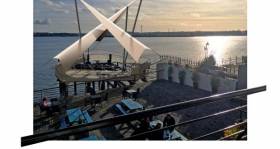Displaying items by tag: SS Titanic
Cobh's Historic Heartbreak Pier Departure Point to be Restored
#CorkHarbour - An historic pier in Cork Harbour, where an estimated 1 million Irish emigrants bade farewell to loved ones as they left for America and Canada is about to be saved in a major €500,000 restoration project.
According to The Irish Times, Heartbreak Pier, as it was dubbed by locals in Cobh, was the departure point for generations of Irish emigrants from the then Queenstown, including the 123 people who boarded the SS Titanic on April 11th, 1912.
The Titanic passengers departed from the White Star Line Pier on board the tenders PS Ireland and PS America to join the ship, which had moored off Roche’s Point before departing for New York.
Of those 123 passengers, just 44 were to survive when, on April 14th, the SS Titanic hit an iceberg some 600km south of Newfoundland and went down with the loss of 1,517 lives.
Click here to read more on this story.
Lecture: Dublin’s Own Titanic-The 'Tayleur'
The venue and is the Dún Laoghaire College of Further Education on Cumberland Street where a lecture series programme is run by the Genealogical Society of Ireland (GSI). For further information on other forthcoming GSI lectures: www.familyhistory.ie/
‘Bounty’ Joins Belfast’s Titanic Maritime Festival
The US-flagged replica tallship H.M.S. Bounty arrived into Belfast Lough this morning for the Belfast Titanic Maritime Festival (24-26 June), writes Jehan Ashmore.
Measuring some 200 tonnes, the three masted-replica ship of the original H.M.A.V Bounty where the famous mutiny against Captain William Bligh took place in Tahiti in 1789, is to open to the public.
The replica was constructed in Nova Scotia of the original Hull-built vessel for the 1962 MGM film 'Mutiny on the Bounty' starring Hollywood screen legend Marlon Brando.
The Bounty was also used in the filming of Pirates of the Caribbean II and a Lone Wolf Production Group documentary on Blackbeard and has featured in several documentaries.
'Bounty' will be open to visitors (for information www.tallshipbounty.org) and is to be accompanied by the Jubilee Sailing Trust's Lord Nelson (www.jst.org.uk/).
The festival venue is at the Queen's Quay, Abercorn Basin and Arc, behind the Premier Inn Hotel at the Titanic Quarter.
As for the Titanic, tours of the old main offices of the H&W shipyard on the Queen's Road courtesy of the Titanic Quarter Ltd will be open to the public with displays relating to Titanic and Edwardian Fashion.
In addition Titanic Bus Tours lasting two hours which are free are available from the Belfast Welcome Centre, to contact Tel: 028 9024 6609.
For a complete listing of the festival events, dates and opening hours go to www.belfastcity.gov.uk/maritimefestival/index.asp
- Belfast
- Port of Belfast
- Lord Nelson
- Belfast Lough
- Titanic
- Jubilee Sailing Trust
- Titanic Quarter
- Belfast Harbour Commissioners
- Tahiti
- Harland & Wolff
- Belfast Lough News
- MGM
- Hollywood
- Maritime Festivals
- Mutiny on the Bounty
- Captain William Bligh
- Marlon Brando
- H.M.S. Bounty
- H.M.A.V. Bounty
- The Bounty
- MGM Film Studies
- Replica tallship
- Maritime Events
- SS Titanic
- H&W
- JST
- Holiday Inn
- Queen's Quay
- Abercorn Basin
- Titanic Quarter Ltd
- Belfast Welcome Centre


























































